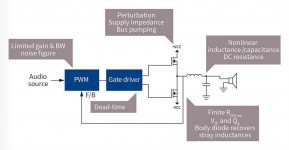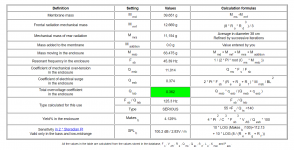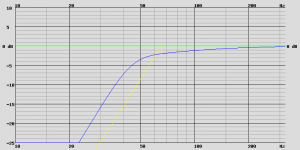Frankly, without making a drawing, this [questionable] one was the best I could/can come up with on the spur of the moment, though figured you or similar would correct me. 😉
Hi,
I must confess i would like a better way to assess this too.
GM, do you think this 'sinergy' does come from impedance relationship?
When i first read the manual wondered if an Firstwatt F-1 ( current drive) would not match better than a typical high damping factor amplifier with Compression Driver?
I've heard nice things from this kind of amp and ATC mid dome, Nelson Pass developed the F1 with HE fullrangers in mind so now i wonder if a dedicated to cd kind of amp could be developed (and upon which design choices)?
Of course i believe amp doesn't have 'sound' ( when used in their SOA and in intended application) but i heard case where indeed a tube amp sounded 'better' than other kind with somekind of loudspeakers ( passive).
I must confess i would like a better way to assess this too.
GM, do you think this 'sinergy' does come from impedance relationship?
When i first read the manual wondered if an Firstwatt F-1 ( current drive) would not match better than a typical high damping factor amplifier with Compression Driver?
I've heard nice things from this kind of amp and ATC mid dome, Nelson Pass developed the F1 with HE fullrangers in mind so now i wonder if a dedicated to cd kind of amp could be developed (and upon which design choices)?
Of course i believe amp doesn't have 'sound' ( when used in their SOA and in intended application) but i heard case where indeed a tube amp sounded 'better' than other kind with somekind of loudspeakers ( passive).
Greets!
Yes in that it need not be tubes since it's due to coupling the driver to an autoformer, so best? way to convert an SS amp to mimic current drive. Decades ago, Carver offered a simple version by inserting a 3 W? resistor in the signal side to mimic it and us DIYers have been known to accept the loss in efficiency and add an inline fuse to speakers.
edit: Sim a vented speaker tuned to Fs, than add 8 ohms if an 8 ohm driver [DF = 1] to be matching impedance, now mod the HF to mirror inductance rise and extend the LF over the double hump tuning impedance with a minor dip in between and extending the simmed roll off at the end of the lower peak to get an idea how much more bass one gets over T/S, though can sound downright flatulent, hence the preference for higher DF if vented.
Compression horns OTOH are highly damped, so depending on the alignment can need > matching impedance for max wide BW.
Yes in that it need not be tubes since it's due to coupling the driver to an autoformer, so best? way to convert an SS amp to mimic current drive. Decades ago, Carver offered a simple version by inserting a 3 W? resistor in the signal side to mimic it and us DIYers have been known to accept the loss in efficiency and add an inline fuse to speakers.
edit: Sim a vented speaker tuned to Fs, than add 8 ohms if an 8 ohm driver [DF = 1] to be matching impedance, now mod the HF to mirror inductance rise and extend the LF over the double hump tuning impedance with a minor dip in between and extending the simmed roll off at the end of the lower peak to get an idea how much more bass one gets over T/S, though can sound downright flatulent, hence the preference for higher DF if vented.
Compression horns OTOH are highly damped, so depending on the alignment can need > matching impedance for max wide BW.
Last edited:
So if you are saying that it is an amplifiers output impedance that makes it sound different, then I agree.
I hate asking questions that have been answered already...but the search function is lack luster... The holes in the Jbl stands aren't exactly 2"...rather...1-7/8...which will result in a 16th inch lip if I'm not mistaken. I forget if I am doing this right...
SOS/(1/16) or SOS/(1/16) and then divide by ?
SOS/(1/16) or SOS/(1/16) and then divide by ?
Last edited:
So if you are saying that it is an amplifiers output impedance that makes it sound different, then I agree.
 😀
😀Thank you GM.
So to be sure i understand the right phenomena: in fact i understand this is the same things which happen with closed loudspeakers that had been designed to 'suit' tube amps out Z ( which sound lean and 'uninteresting' once driven by a SS amp). Which makes sense to me as compression drivers are closed box after all.
Ok now i wonder why an amp with higher Z out would brings benefits to a cd? Better control/damping?
Will have to reread some things...
So to be sure i understand the right phenomena: in fact i understand this is the same things which happen with closed loudspeakers that had been designed to 'suit' tube amps out Z ( which sound lean and 'uninteresting' once driven by a SS amp). Which makes sense to me as compression drivers are closed box after all.
Ok now i wonder why an amp with higher Z out would brings benefits to a cd? Better control/damping?
Will have to reread some things...
The holes in the Jbl stands aren't exactly 2"...rather...1-7/8...which will result in a 16th inch lip if I'm not mistaken.
Really?!
Correct.
~13543/pi/1.875" = ~2299.13 Hz Vs 2" = ~2155.43 Hz, though the way to look at it is that it will cause reflections back to the driver throat, comb filtering with pretty much all its HF.
So to be sure i understand the right phenomena:
Better control/damping?
You're welcome!
Correct.
Correct in that compression drivers are under-damped by design since the horn [WG not so much] is an intrinsically over-damped device, so historically only critically damped if a full expo, but if you [can] tune the rear chamber to the horn's mean you can near enough balance out other types to a greater or lesser extent [to my ears anyway].
It matters not to me what the amps output impedance is, there is no optimal. But what is essential is that it is standard. A passive crossover designed for one impedance is now completely wrong for another, hence its "sound" changes. Now you may prefer this new "modified" sound but it is not what was intended unless the speakers were designed with that specific impedance in mind.
This is precisely why a very low impedance is, buy far, the most common target and just about 100% of what speakers are designed to. So on a tube amp the sound changes - detunes - and people think that's great and/or magical. Go figure.
This is precisely why a very low impedance is, buy far, the most common target and just about 100% of what speakers are designed to. So on a tube amp the sound changes - detunes - and people think that's great and/or magical. Go figure.
Thanks for the positivity guys...I don't want to let you down. You've all taught me so much. Its hard to make big rigidly square boxes look sexy but I will try...I have some black brushed aluminum veneer that might make it to the faces....some kind of sand/epoxy mix might go on the top/bottom/sides...
You're welcome!
Correct.
Correct in that compression drivers are under-damped by design since the horn [WG not so much] is an intrinsically over-damped device, so historically only critically damped if a full expo, but if you [can] tune the rear chamber to the horn's mean you can near enough balance out other types to a greater or lesser extent [to my ears anyway].
How can we determine ideal damping factor for a specific horn?
Hi,
GM, Earl thank you both.
This make me understand horn+cd more confidently now: what you explained GM was the missing link from a previous exchange with Earl (when we talked about constant directivity horns, loading and the use of eq and the fact this couple is minimum phase behavior).
I think i was puzzled by the fact the couple is almost never presented as this (a couple, but well maybe it is presented like that and i didn't understood) whose the total result is the sum of both behaviors of driver/horn.
Makes much more sense in my mind now.
Earl,
I agree with you about amps. And in my own config amp change gives marginal or no difference to me ( dsp filter/multiamp).
But still even if not 'right' i understand some people can enjoy some artefacts in reproduction. This can make 'fun' system to listen to. Not what i would want all day but it can be enjoyable experience.
Plasnu i would aim to the best possible transient/impulse response possible for the couple.
When i understood a cd was a closed box system i could'nt help myself and immediatly thoughts about Linkwitz Transform ( i'm addicted to LT!). Then the xmax brought me back to reality but still there is room to play given the efficiency a cd allow an approaching this in a 'lossy' way...
I would like to give this a try at one point. Will have to find a cheap guinea pig cd as i predict bad things will happen ( i know how fine and subtil i can be sometime...).
Camplo,
Form follow function.
And tbh who care about the look... those are tools!
Just by there size these are already impressive looking loodspeakers. Once a horn added they will be even more 'horn system' looking! 😉
Anyway if look matter to you you could always laminate anything to the box later. There is very nice things in laminate...
Or even more open is (car) 'covering'/'warping'. If good enough for a Lamborghini supercar... 😉
GM, Earl thank you both.
This make me understand horn+cd more confidently now: what you explained GM was the missing link from a previous exchange with Earl (when we talked about constant directivity horns, loading and the use of eq and the fact this couple is minimum phase behavior).
I think i was puzzled by the fact the couple is almost never presented as this (a couple, but well maybe it is presented like that and i didn't understood) whose the total result is the sum of both behaviors of driver/horn.
Makes much more sense in my mind now.
Earl,
I agree with you about amps. And in my own config amp change gives marginal or no difference to me ( dsp filter/multiamp).
But still even if not 'right' i understand some people can enjoy some artefacts in reproduction. This can make 'fun' system to listen to. Not what i would want all day but it can be enjoyable experience.
Plasnu i would aim to the best possible transient/impulse response possible for the couple.
When i understood a cd was a closed box system i could'nt help myself and immediatly thoughts about Linkwitz Transform ( i'm addicted to LT!). Then the xmax brought me back to reality but still there is room to play given the efficiency a cd allow an approaching this in a 'lossy' way...
I would like to give this a try at one point. Will have to find a cheap guinea pig cd as i predict bad things will happen ( i know how fine and subtil i can be sometime...).
Camplo,
Form follow function.
And tbh who care about the look... those are tools!
Just by there size these are already impressive looking loodspeakers. Once a horn added they will be even more 'horn system' looking! 😉
Anyway if look matter to you you could always laminate anything to the box later. There is very nice things in laminate...
Or even more open is (car) 'covering'/'warping'. If good enough for a Lamborghini supercar... 😉
Last edited:
How can we determine ideal damping factor for a specific horn?
I had a similar question...basically...how to judge Q of vented design or rather why doesn't the sim software predict Q at tuning for vented designs...I figured one way is to measure it with DATS.
Noise is the biggest problem with amplifiers + compression drivers.
Tubes can be made dead silent, but those amps tend to be expensive.
In this respect most class D amps are generally more than adequate.
Still, Class D is immature technology and refinements are plentiful, with GaN being the current SOTA tech.
Tubes can be made dead silent, but those amps tend to be expensive.
In this respect most class D amps are generally more than adequate.
Still, Class D is immature technology and refinements are plentiful, with GaN being the current SOTA tech.
Attachments
I had a similar question...basically...how to judge Q of vented design or rather why doesn't the sim software predict Q at tuning for vented designs...I figured one way is to measure it with DATS.
You mean Box Q?
I use the French online calculator and verify the sim in VituixCAD.
Attachments
I think this is at least on the right path....Looking for basically Qtv...System Q of a vented enclosure, so to say if you were aiming for critical damping?
Camplo,
I see a way to check it:
You could generate an 'ideal' freq curve template from Rephase and from then tweak Hornresp realtime until both curves are close enough and from then fine tune. I find the impulse response function very handy to check for alignement scenario ( but to have a Q display could be even better... maybe there is a way to have it but i didn't find).
I recently been convinced to gives Hornresp a serious dive ( thanks Kaffimann! I'm slow but i'm on it...) and like Ro808 i use Dominique Petoin's site as a start and then check results from different simulators.
I see a way to check it:
You could generate an 'ideal' freq curve template from Rephase and from then tweak Hornresp realtime until both curves are close enough and from then fine tune. I find the impulse response function very handy to check for alignement scenario ( but to have a Q display could be even better... maybe there is a way to have it but i didn't find).
I recently been convinced to gives Hornresp a serious dive ( thanks Kaffimann! I'm slow but i'm on it...) and like Ro808 i use Dominique Petoin's site as a start and then check results from different simulators.
In practice, the tuning and damping can depend on several factors. The above example illustrates a low xmax midwoofer in a slightly oversized cabinet with port tuning slightly below Fs.
The intended response is imo ideally suited for an average European room.
Depending on the parameters of the driver and the application, you can opt for a specific alignment. The Q is just a hypothetical value and doesn't tell us much about the actual driver in a specific cabinet in a specific room.
The intended response is imo ideally suited for an average European room.
Depending on the parameters of the driver and the application, you can opt for a specific alignment. The Q is just a hypothetical value and doesn't tell us much about the actual driver in a specific cabinet in a specific room.
Attachments
Last edited:
- Home
- Loudspeakers
- Multi-Way
- Is it possible to cover the whole spectrum, high SPL, low distortion with a 2-way?



